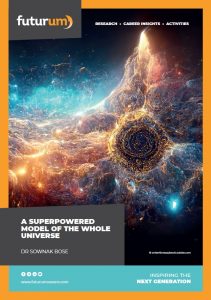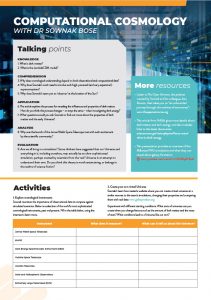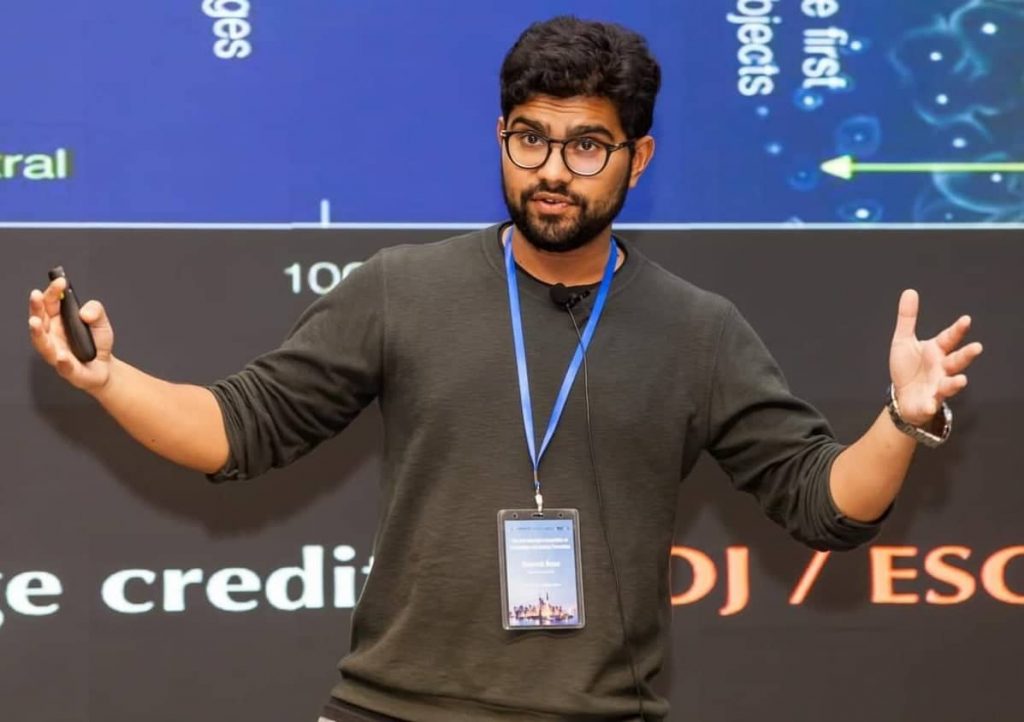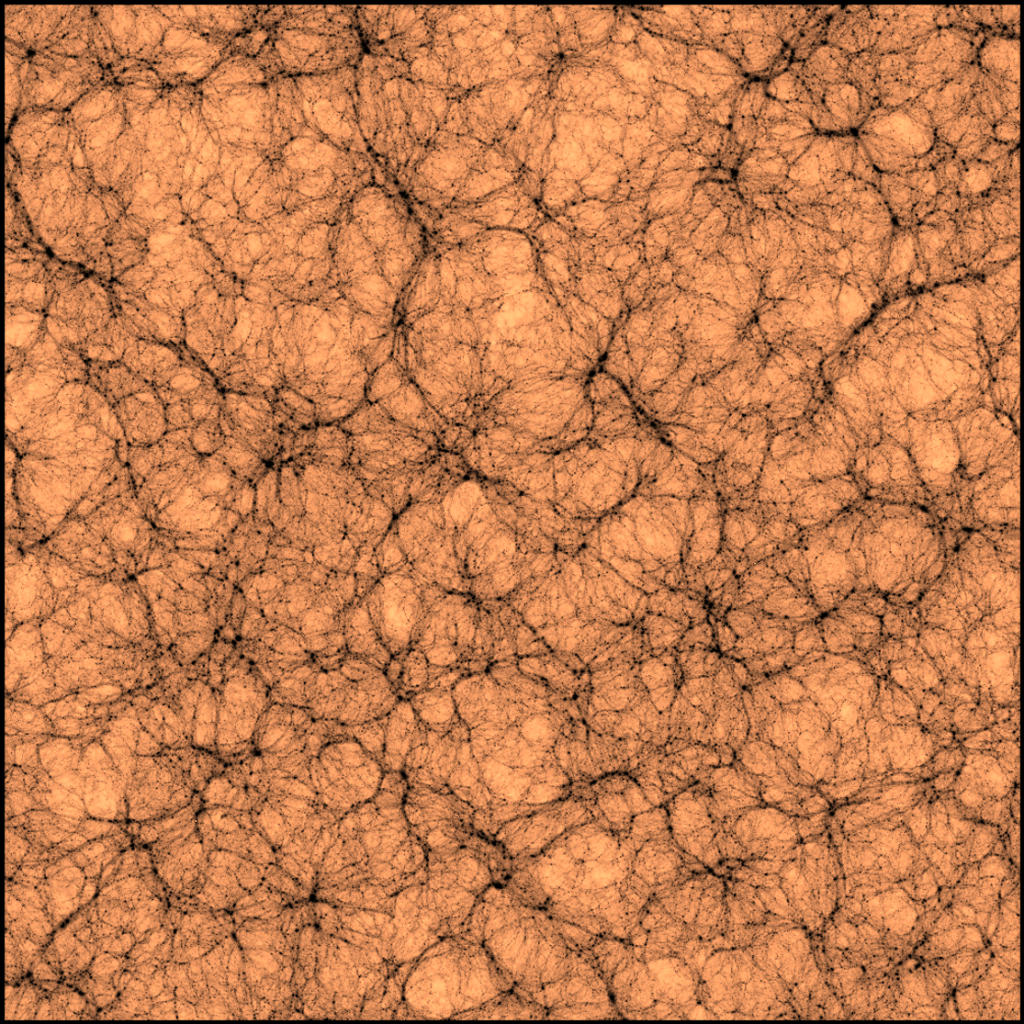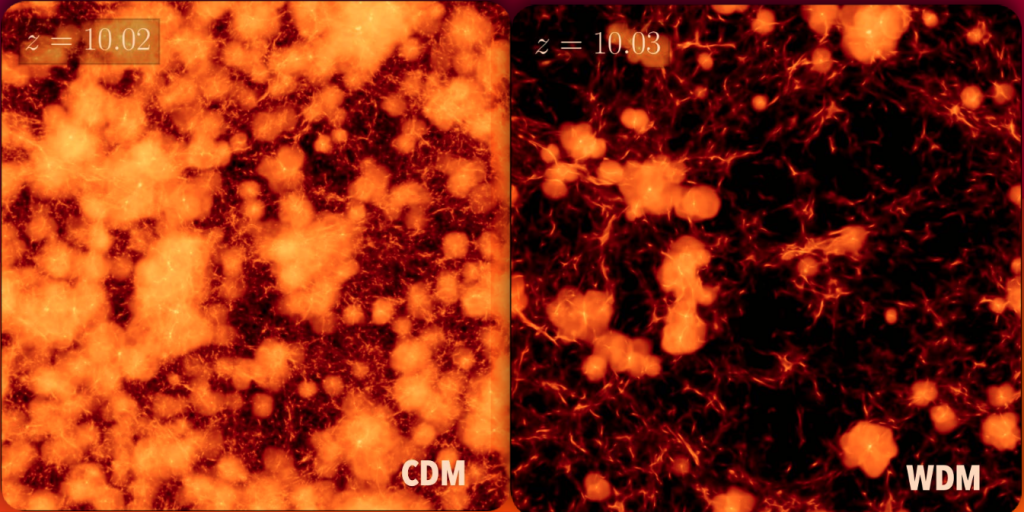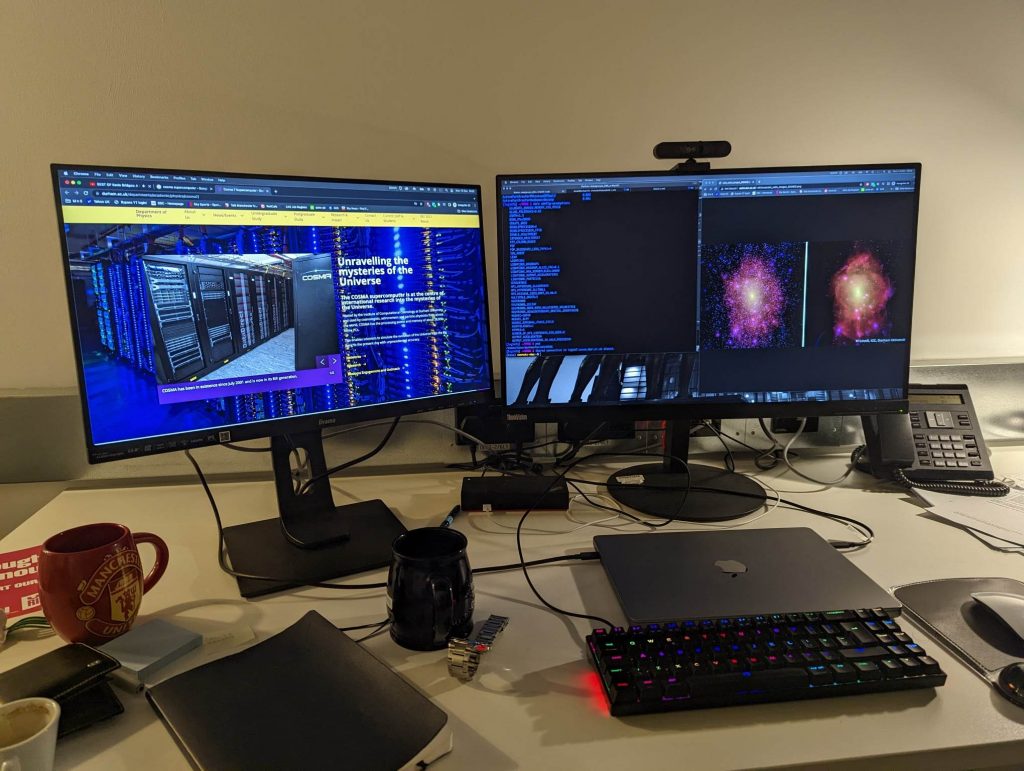A superpowered model of the whole universe
The mysterious substance of dark matter and the enigmatic force of dark energy may hold the key to how the Universe formed. But how can scientists study something that cannot be seen or explained? At Durham University in the UK, Dr Sownak Bose is using techniques from computational cosmology to uncover the mysteries of the early Universe.
TALK LIKE A COMPUTATIONAL COSMOLOGIST
Dark energy — a theoretical form of energy thought to act in opposition to gravity and drive the accelerating expansion of the Universe
Dark matter — a theoretical form of matter that has significant gravitational effects on the Universe
Gravitational lens — matter between a distant light source and an observer that can bend the emitted light through its gravity
Gravity — the force that attracts a body towards the centre of another body due to its mass
Intensity mapping — using radio waves to survey the large-scale structure of the Universe
Supercomputer — a computer with a very high level of performance
There are mysterious forces at work around us. Scientists have long pondered over unseen but important sources of gravity and energy that have shaped the development of the Universe. “Dark matter and dark energy are terms used by astronomers to describe some of the strange observed phenomena that we see in the Universe, but that we can’t explain with standard physics,” explains Dr Sownak Bose, a computational cosmologist at Durham University. “The term ‘dark’ doesn’t just mean we can’t see it; it also means that we don’t understand it!”
However, our understanding is increasing every day as the technology and techniques used to observe and model the Universe become ever-more advanced. Sownak is contributing to solving these mysteries by developing sophisticated simulations of the Universe using high-powered supercomputers.
The power of dark matter
Gravity is key to the makeup of our Universe. Any object with mass generates gravity, and the bigger the mass, the bigger the gravitational field. It is gravity that keeps us fixed to our planet, our planet orbiting the Sun, and the Sun orbiting the centre of the Milky Way galaxy. “In the mid-20th century, astronomers observed that stars on the outskirts of galaxies appeared to be moving much faster than would be expected based on the observed mass of the galaxies’ centres,” says Sownak. “This implied there was extra mass somewhere that we couldn’t see. It was hypothesised that galaxies must be surrounded by invisible ‘haloes’ of matter that generated this extra gravity.”
This unobservable matter was termed ‘dark matter’, and it has since been realised that it may hold the key to the formation of galaxies and of the Universe itself. “Because ordinary matter can ‘feel’ the gravitational influence of dark matter, concentrated spots of dark matter draw ordinary matter towards them,” says Sownak. “In the early Universe, these spots would have drawn in hydrogen gas, collecting and compressing the gas into highly dense structures that ultimately became stars and galaxies.”
Dark matter is very difficult to study because it appears to have little or no interaction with ordinary matter, except through gravity. “We can’t observe dark matter using the electromagnetic spectrum – it doesn’t interact with light, for instance,” says Sownak. “Instead, we have to find ways to infer its presence.” One method of inference is called gravitational lensing, which refers to how far-away galaxies appear ‘stretched’ when viewed through a powerful telescope. “This stretching implies there’s a large gravitational field in between us and the galaxy. We can’t see a source, but we can infer it.”
Simulations and observations
Computer modelling has revealed that properties of the early Universe were strongly dependent on the properties of dark matter. To determine exactly what these properties were involves altering them in a model and then comparing the model results to real world observations. One such technique is intensity mapping, which uses large arrays of radio telescopes to map the distribution of radiation that was created by the first stars and galaxies, which can be used to infer when and where these stars and galaxies were born. Comparing modelled and observed data has led astronomers to settle on the properties of dark matter within the Lambda Cold Dark Matter (LambdaCDM) model as the best theory we have, so far, for the formation of galaxies and other structures. “We find high levels of similarities when comparing the predictions of this model with observed data,” explains Sownak.
These two main sources of data – observations and simulations – both rely upon the other to push the boundaries of our knowledge. “Sometimes, testing a robust simulation of a theory requires observations beyond the capabilities of our telescopes and other technologies,” says Sownak. “That’s why there is so much excitement when new technologies launch, like the James Webb Space Telescope (launched in 2021), because they open up a huge array of new possibilities.”
Creating a virtual Universe
“We have to ensure our theoretical predictions match the observed Universe as faithfully as possible, so we don’t come to misleading conclusions,” explains Sownak. “This involves very detailed and realistic simulations, which require a lot of work and computing power.” Collaborative efforts between Durham University in the UK, the Max Planck Institute for Astrophysics in Germany, and Harvard University in the US have led to one of the most sophisticated simulations of galaxy formation ever created.
“The MilleniumTNG simulation is enormous in size and has extremely high-resolution,” says Sownak. “To bring it to life, we had to develop new computational techniques and use state-of-the-art supercomputers.” The main calculation took 57 days to process and involved 122,880 supercomputer processing units. This model produced fascinating findings, and Sownak believes they have only just scratched the surface.
The aim is for it to be possible to model any ‘real-life’ observation within the simulations to indicate their level of accuracy, in particular the role of dark matter in the early days of the Universe. For instance, the team’s largest and most detailed simulations, using the LambdaCDM, produce modelled galaxies similar to our own Milky Way. “We can actually place an ‘observer’ within this simulation at the location of our Sun to act as a viewpoint for observing the virtual Universe,” says Sownak. “Then, we compare this virtual ‘viewpoint’ to our own. If we’ve got the model right, they should match.” The models show high levels of agreement with observed data, though the latest data from the James Webb Space Telescope has highlighted some mismatches, which could be due to uncertain observations or incomplete theoretical models. This indicates that even with these highly sophisticated models, there is still more to be done – and much to discover.
Reference
https://doi.org/10.33424/FUTURUM347
From dark matter to dark energy
As the science around dark matter becomes more established, focus turns to the exploration of another mysterious force – dark energy. It has been observed that the Universe is expanding outwards, and this expansion is accelerating. As with dark matter, we cannot see what is driving this. “Dark energy plays very much the opposite role to dark matter,” says Sownak. “Rather than bringing material together through gravity, dark energy drives the accelerated expansion of the Universe.”
Just like the expansion of the Universe, our understanding of this phenomenon is accelerating as technologies and computers become more sophisticated. “I am very interested in seeing what the next decade brings,” says Sownak. “There’s an enormous community effort happening to map the large-scale structure of the Universe through time in exquisite detail.” This includes powerful observational instruments such as the Dark Energy Spectroscopic Instrument (DESI) survey, and space-based surveys like Euclid that are currently in development.
Like much of science, the hope is not just to use these observations to rule out theories, but to also develop and explore new ideas. “This next level of statistical precision will enable us to disprove certain cosmological models attempting to explain accelerated expansion,” says Sownak. “It’s possible we’re in for a far bigger surprise than anticipated – it might turn out that Einstein’s theory of general relativity is not the final answer to the laws of gravity after all!”
 DR SOWNAK BOSE
DR SOWNAK BOSE
Institute for Computational Cosmology, Department of Physics, Durham University, UK
Field of research: Computational Cosmology
Research summary: Using sophisticated simulations of the Universe to uncover the properties of dark matter and how it influenced the development of galaxies and stars
Funder: UK Research and Innovation (UKRI) Future Leaders Fellowship (grant number MR/V023381/1)
About computational cosmology
Cosmology is the branch of astrophysics that studies the development of the Universe. As computers have become more powerful in recent decades, computational cosmology has become an important branch of the field. Supercomputers can process vast quantities of data and provide a means to model the Universe through time. These can be compared with real-life observations to reveal the most likely scenarios for the formation and development of the Universe. Sownak explains more about this field:
“Cosmology is a unique subject because of the enormous range of scales involved. A typical cosmological simulation requires solving the laws of physics covering scales from tens to billions of light years. Such calculations would take hundreds of years to process on everyday computers, but supercomputers can perform them within months or weeks! Supercomputers are essentially many thousands of ‘ordinary’ computers linked up into one system where all their computational power is addressing a specific problem.
“Particle physics, cosmology and high-performance computing can be thought of as three rungs on a ladder. The theories of particle physics give us interesting models for dark matter and their underlying equations. The laws of cosmology – gravity, dark energy, etc. – tell us how our simulated Universe should evolve and what to expect. Finally, high-performance computing helps us combine inputs from particle physics and cosmology so we can perform these calculations efficiently.
“One of the coolest aspects of my work is that I’m studying questions that nobody has looked into before. I am often the first person to actually visualise how the Universe might look under different theories for dark matter. Being at the cutting edge of such questions is fascinating for me!
“Problem solving and computer programming are obvious skills useful to computational cosmologists. But I also think that two underrated skills are public speaking and writing. One of a scientist’s most important responsibilities is to communicate our findings. The ability to speak and write coherently on complex subjects is extremely important.”
Pathway from school to computational cosmology
• Sownak recommends studying maths and physics at school and post-16 to learn the fundamentals of cosmology. He also advises gaining exposure to computer programming as soon as possible, as computing is essential for many fields of science.
• University degrees in physics, astrophysics, astronomy or computer science could all lead to a career in computational cosmology.
Explore careers in computational cosmology
• Most computational cosmologists work in universities or research institutions, where they develop computer simulations to advance our understanding of the Universe.
• The Institute of Computational Cosmology at Durham University runs an active outreach programme, where you can learn more about the Universe: icc.dur.ac.uk/index.php?content=Outreach/Outreach
• The Astronomy Group at Durham University also participates in science festivals and invites school students to participate in internships with researchers in the department: www.astro.dur.ac.uk
• The Royal Astronomical Society hosts an array of educational materials and provides details of astronomers in the UK who are willing to do outreach: www.ras.ac.uk/education-and-careers/outreach
• Prospects provides information about careers in the wider field of astronomy, including the qualifications you need and the salary you can expect: www.prospects.ac.uk/job-profiles/astronomer
Meet Sownak
As a child, my dream was to be a football manager – maybe it still is! I then wanted to be a writer, then an economist. My interest in science came rather late. I’d never anticipated the career I am in now, and don’t think I had any special scientific aptitude when I was younger!
As a teen, a TV documentary on cosmology and the Universe had a profound impact on me. I think my eventual journey into cosmology was driven by the fascination sparked by the questions it explored about the origins of the cosmos. I even had my university applications all prepared to study economics when I watched it – so if not for that one night in front of the TV, who knows?
A main career highlight for me is working with students and young researchers. Watching them develop into independent researchers is the most rewarding career an academic can have. The UKRI grant I have gives me the flexibility to build a group with a research strategy and culture that’s consistent with my ideals. I hope to develop this group, so its members become both scientific and community leaders.
Research is funded with public money, so I believe that giving back to the community is an important responsibility for researchers. I also believe that science communication is important to help us reflect on how to effectively translate our work into something impactful. It’s common to find that explaining a complex theory in non-technical terms actually helps me understand these complex ideas better.
For me, some of the most fun outreach activities involve talking about astronomy to school children. This is particularly true when visiting areas where research careers might seem impossible. I recently worked on a project exploring the connections between physics and football. It was great to see the wonder in kids’ faces when revealing the physics behind their favourite sport!
The most exceptional thing about cosmology is that, despite the fact that we as humans occupy such a minuscule fraction of the cosmos, we can create and test theories about the formation and development of the Universe over the course of its 14-billion-year lifespan.
I mainly spend my free time watching, writing about and ranting about football. I’m also currently creating an astronomy-themed podcast called The Open Universe which discusses both old and new topics in an informal way.
Sownak’s top tips
1. Find something that excites you and that you are passionate about.
2. Don’t worry about whether you are ‘smart enough’ to pursue science. As long as you are motivated, everything else will fall into place.
Do you have a question for Sownak?
Write it in the comments box below and Sownak will get back to you. (Remember, researchers are very busy people, so you may have to wait a few days.)

